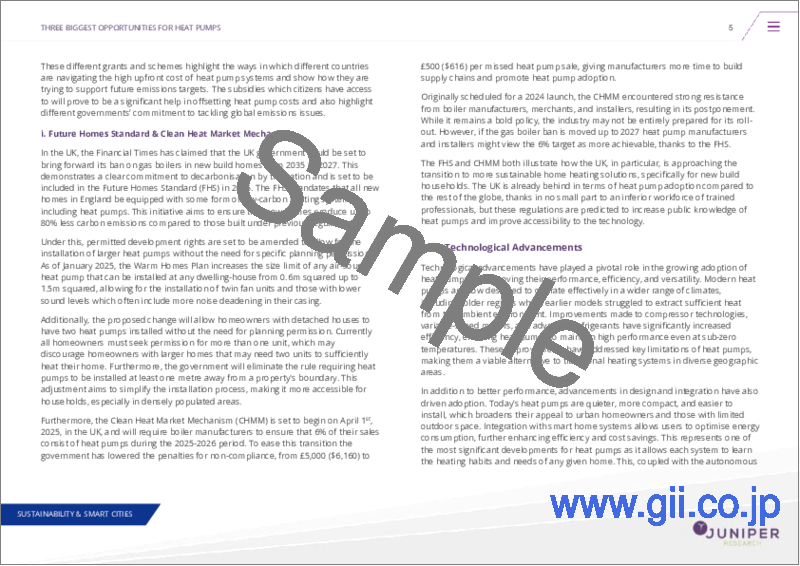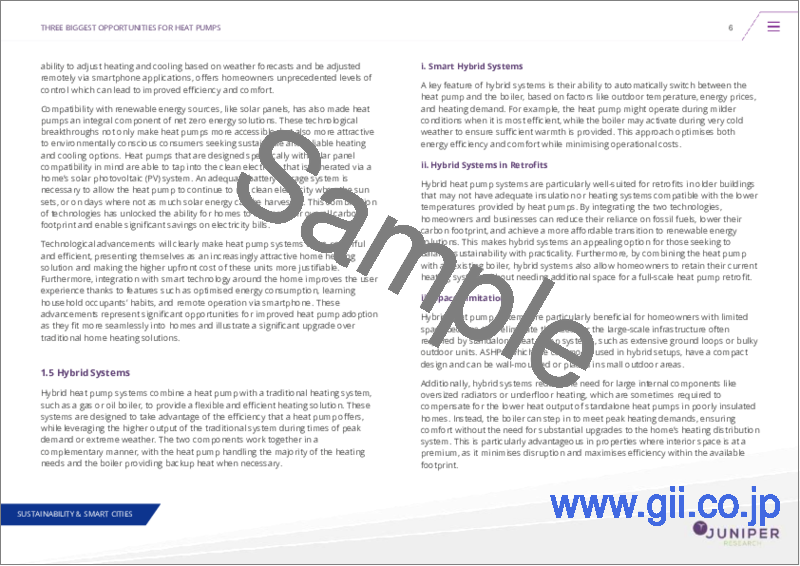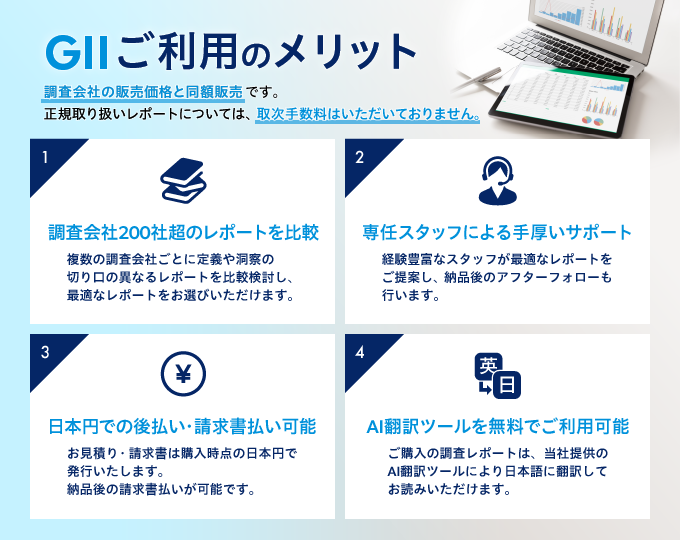|
|
市場調査レポート
商品コード
1657999
ヒートポンプの世界市場:2025-2029年Global Heat Pump Market: 2025-2029 |
||||||
|
|||||||
| ヒートポンプの世界市場:2025-2029年 |
|
出版日: 2025年02月25日
発行: Juniper Research Ltd
ページ情報: 英文
納期: 即日から翌営業日
|
全表示
- 概要
- 目次
2029年には世界の住宅の10%にヒートポンプが導入される見通し
| 主要統計 | |
|---|---|
| 2025年の世界のヒートポンプハードウェア収益: | 840億米ドル |
| 2029年の世界のヒートポンプハードウェア収益: | 1,420億米ドル |
| 2025年から2029年の市場成長率: | 69% |
| 予測期間: | 2025-2029年 |
当調査パッケージは、ヒートポンプ市場の詳細な分析を提供します。持続可能な暖房ソリューションプロバイダーは、主要動向と課題、潜在的成長機会、競合環境を理解することができます。
本調査には、ヒートポンプ市場の今後の成長をマッピングするデータへのアクセスや、詳細なレポートが含まれています。また、ヒートポンプ市場の主要14社に関する広範な分析から、同市場における最新の事業機会と動向を明らかにします。関連するさまざまな技術、さまざまな分野の需要、ヒートポンプの導入に影響を与える促進要因と課題的要因などの課題についても、レポート全体を通して探求しています。
主な特徴
- 市場力学:ヒートポンプ市場における持続可能な暖房の主要動向と市場拡大の課題を洞察を提供します。初期費用、既存の政府補助金や制度がもたらす課題を取り上げ、さまざまな分野でのさまざまなヒートポンプの用途を分析しています。また、ヒートポンプシステムとその用途の将来の展望も示しています。
- 主な要点と戦略的提言:市場開拓の主な機会と調査結果を詳細に分析し、ヒートポンププロバイダー向けに、新たな動向と市場の今後の展開に関する戦略的提言を提供します。
- ベンチマークとなる業界予測:ヒートポンプ市場の予測には、総収益、設置数、ヒートポンプ導入により節約されたエネルギー総量が含まれます。このデータセットは、世界市場の展望を提供するだけでなく、以下に分類される主要な垂直分野ごとの展望も示します。
- 住宅用ヒートポンプ
- 商業用/産業用ヒートポンプ
- 電気自動車用ヒートポンプ
市場データ・予測
当調査スイートには、61の表と27,000以上のデータポイントから成る予測データ一式へのアクセスが含まれています。この調査スイートには以下の指標が含まれています。
- ヒートポンプの総設置数
- EVを含むヒートポンプへの総支出額
- ヒートポンプによって節約された総エネルギー量
これらの指標は、以下の主要市場について提供されています:
- 住宅用ヒートポンプ
- 空気熱源ヒートポンプ
- 地中熱ヒートポンプ
- 水熱源ヒートポンプ
- 業務用ヒートポンプ
- 空気熱源ヒートポンプ
- 地中熱ヒートポンプ
- 水熱源ヒートポンプ
- EVヒートポンプ
Juniper Researchのインタラクティブ予測 (Excel) には、以下の機能があります:
- 統計分析:データ期間中のすべての地域と国について表示される特定の指標を検索できるのがメリットです。グラフは簡単に修正でき、クリップボードへのエクスポートも可能です。
- 国別データツール:このツールでは、予測期間中のすべての地域と国の指標を見ることができます。ユーザーは検索バーで表示される指標を絞り込むことができます。
- 国別比較ツール:国を選択し、それぞれの国を比較することができます。このツールには、グラフをエクスポートする機能が含まれています。
- What-if分析:ここでユーザーは、予測指標を独自の前提条件と比較することができます。
サンプルビュー
市場動向・予測 (PDFレポート)

目次
第1章 重要ポイントと戦略的推奨事項
- 重要ポイント
- 戦略的推奨事項
第2章 市場情勢
- ヒートポンプの種類
- ヒートポンプ導入の促進要因
- 脱炭素化目標
- 助成金と制度
- 技術の進歩
- 主な課題
- コストの上昇
- 規模の経済
- レトロフィット
- 寒冷気候でのパフォーマンス
- グリッドへの依存
第3章 セグメント分析
- 消費者向けおよび商業用ヒートポンプ
- メリット
- デメリット
- ハイブリッドシステム
- 最近の動向
- 今後の展望
- 産業用ヒートポンプ
- メリット
- デメリット
- 地域暖房
- 冷却ネットワーク
- 最近の動向
- 今後の展望
- 自動車用ヒートポンプ
- メリット
- デメリット
- 持続可能性と排出量の削減
- 最近の動向
- 今後の展望
第4章 Juniper Researchのヒートポンプ競合リーダーボード
- ベンダープロファイル
- Carrier
- Daikin
- Grant
- Hitachi
- Lennox
- LG
- Mitsubishi Electric
- NIBE
- Panasonic
- Samsung
- Stiebel Eltron
- Trane
- Vaillant
- Worcester Bosch
第5章 市場予測
- 調査手法と前提
- ヒートポンプ:概要
- 設置総数
- EVを含む総支出額
- 総エネルギー節約量
- 住宅用ヒートポンプ
- 設置総数
- EVを含む総支出額
- 総エネルギー節約量
- 事業用ヒートポンプ
- 設置総数
- EVを含む総支出額
- 総エネルギー節約量
- EVヒートポンプ
- 設置総数
- EVを含む総支出額
'Heat Pumps Installed in 10% of Homes Globally by 2029'
| KEY STATISTICS | |
|---|---|
| Heat pump hardware revenue globally in 2025: | $84bn |
| Heat pump hardware revenue globally in 2029: | $142bn |
| 2025 to 2029 market growth: | 69% |
| Forecast period: | 2025-2029 |
Overview
Our "Heat Pump" market research suite provides detailed analysis of this emerging market; allowing sustainable heating solution providers to gain an understanding of key trends and challenges, potential growth opportunities, and the competitive environment.
Providing multiple options that can be purchased separately, the research suite includes access to data mapping the future growth of the heat pump market, and an in-depth written study. This study reveals the latest opportunities and trends within the market, containing an extensive analysis of 14 leading heat pump providers within the space. Aspects such as the different technologies involved, the demands of different sectors, and the driving and challenging factors affecting heat pump adoption are explored throughout the report.
Collectively, these elements provide an effective tool for understanding this evolving market; allowing heat pump vendors to set out their future strategies to provide effective and efficient heating and cooling solutions to their customers. Its unparalleled coverage makes this research suite an incredibly useful resource for gauging the future of this complex market.
Key Features
- Market Dynamics: Insights into key sustainable heating trends and market expansion challenges within the heat pump market. It addresses challenges posed by upfront costs, existing government grants and schemes, and analyses the applications of different heat pumps in different sectors. The research also provides a future outlook on the landscape of heat pump systems and their applications.
- Key Takeaways & Strategic Recommendations: In-depth analysis of key development opportunities and findings within this market, accompanied by key strategic recommendations for heat pump providers on emerging trends and how the market is expected to evolve.
- Benchmark Industry Forecasts: The forecasts for the heat pump market include total revenue, number of instalments, and total amount of energy saved via heat pump deployment. This dataset not only provides a global market view, but is also split between key verticals, including:
- Residential Heat Pumps
- Commercial/Industrial Heat Pumps
- Electric Vehicle Heat Pumps
The forecasts include data on heat pumps in residential and business applications, split by air-source, water-source, and ground-source heat pumps. Furthermore, it provides an insight into heat pump adoption in electric vehicles.
- Juniper Research Competitor Leaderboard: Key player capability and capacity assessment for 14 heat pump vendors, via the Juniper Research Competitor Leaderboard. The list of vendors profiled comprises:
- Carrier
- Daikin
- Grant
- Hitachi
- Lennox
- LG
- Mitsubishi
- NIBE
- Panasonic
- Samsung
- Stiebel Eltron
- Trane
- Vaillant
- Worcester Bosch
Market Data & Forecasts
The market-leading research suite for the "Heat Pump" market includes access to the full set of forecast data, consisting of 61 tables and over 27,000 datapoints. Metrics in the research suite include:
- Total Number of Heat Pumps Installed
- Total Spend on Heat Pumps, Including Electric Vehicles (EVs)
- Total Energy Saved via Heat Pumps
These metrics are provided for the following key market verticals:
- Residential Heat Pumps
- Air-source Heat Pumps
- Ground-source Heat Pumps
- Water-source Heat Pumps
- Business Heat Pumps
- Air-source Heat Pumps
- Ground-source Heat Pumps
- Water-source Heat Pumps
- EV Heat Pumps
The Juniper Research Interactive Forecast Excel contains the following functionality:
- Statistics Analysis: Users benefit from the ability to search for specific metrics, displayed for all regions and countries across the data period. Graphs are easily modified and can be exported to the clipboard.
- Country Data Tool: This tool lets the user look at metrics for all regions and countries in the forecast period. Users can refine the metrics displayed via the search bar.
- Country Comparison Tool: Users can select countries and compare each of them. The ability to export graphs is included in this tool.
- What-if Analysis: Here, users can compare forecast metrics against their own assumptions. 5 interactive scenarios.
SAMPLE VIEW
Market Trends & Forecasts PDF Report

A comprehensive analysis of the current market landscape, alongside strategic recommendations and a walk-through of the forecasts.
Table of Contents
1. Key Takeaways & Strategic Recommendations
- 1.1. Key Takeaways
- 1.2. Strategic Recommendations
2. Market Landscape
- 2.1. Introduction
- 2.2. Types of Heat Pump
- 2.3. Driving Factors to Heat Pump Adoption
- 2.3.1. Decarbonisation Goals
- 2.3.2. Grants & Schemes
- i. Future Homes Standard & Clean Heat Market Mechanism
- 2.3.3. Technological Advancements
- 2.4. Key Challenges
- 2.4.1. Higher Costs
- 2.4.2. Economies of Scale
- Table 2.1: Average Price per Heat Pump Unit ($), Globally, Split by 8 Key Regions, 2024-2029
- 2.4.3. Retrofitting
- 2.4.4. Cold Climate Performance
- 2.4.5. Dependency on the Grid
3. Segment Analysis
- 3.1. Consumer & Commercial Heat Pumps
- 3.1.1. Advantages
- 3.1.2. Disadvantages
- 3.1.3. Hybrid Systems
- i. Smart Hybrid Systems
- ii. Hybrid Systems in Retrofits
- iii. Space Limitations
- 3.1.4. Recent Developments
- 3.1.5. Future Outlook
- 3.2. Industrial Heat Pumps
- 3.2.1. Advantages
- 3.2.2. Disadvantages
- Figure 3.1: Average Cost of Industrial Heat Pumps ($), Globally, Split by 8 Key Regions, 2025
- 3.2.3. District Heating Applications
- 3.2.4. Cooling Network Applications
- 3.2.5. Recent Developments
- 3.2.6. Future Outlook
- 3.3. Automotive Heat Pumps
- 3.3.1. Advantages
- 3.3.2. Disadvantages
- 3.3.3. Sustainability and Reduced Emissions
- 3.3.4. Recent Developments
- 3.3.5. Future Outlook
4. Juniper Research Heat Pump Competitor Leaderboard
- Table 4.1: Juniper Research Competitor Leaderboard Heat Pump Vendors Included & Product Portfolios
- Figure 4.2: Juniper Research Competitor Leaderboard: Heat Pumps
- Table 4.3: Juniper Research Heat Pump Vendors & Positioning
- Table 4.4: Juniper Research Competitor Leaderboard Heatmap for Heat Pump Vendors
- 4.1. Vendor Profiles
- 4.1.1. Carrier
- i. Corporate
- Figure 4.5: Carrier, Financial Snapshot ($m), 2022-2023
- ii. Geographical Spread
- iii. Key Clients & Strategic Partnerships
- iv. High-level View of Offerings
- v. Juniper Research's View: Key Strengths & Strategic Opportunities
- i. Corporate
- 4.1.2. Daikin
- i. Corporate
- Figure 4.6: Daikin, Financial Snapshot ($m), 2022-2023
- ii. Geographical Spread
- iii. Key Clients & Strategic Opportunities
- iv. High-level View of Offerings
- v. Juniper Research's View: Key Strengths & Strategic Opportunities
- i. Corporate
- 4.1.3. Grant
- i. Corporate
- ii. Geographical Spread
- iii. Key Clients & Strategic Opportunities
- iv. High-level View of Offerings
- v. Juniper Research's View: Key Strengths & Strategic Opportunities
- 4.1.4. Hitachi
- i. Corporate
- Figure 4.7: Hitachi Financial Snapshot ($m), 2022-2023
- ii. Geographical Spread
- iii. Key Clients & Strategic Opportunities
- iv. High-level View of Offerings
- v. Juniper Research's View: Key Strengths & Strategic Opportunities
- i. Corporate
- 4.1.5. Lennox
- i. Corporate
- Figure 4.8: Lennox Financial Snapshot ($m), 2022-2023
- ii. Geographical Spread
- iii. Key Clients & Strategic Opportunities
- iv. High-level View of Offerings
- v. Juniper Research's View: Key Strengths & Strategic Opportunities
- i. Corporate
- 4.1.6. LG
- i. Corporate
- Figure 4.9: LG Financial Snapshot ($m), 2022-2023
- ii. Geographical Spread
- iii. Key Clients & Strategic Opportunities
- iv. High-level View of Offerings
- v. Juniper Research's View: Key Strengths & Strategic Opportunities
- i. Corporate
- 4.1.7. Mitsubishi Electric
- i. Corporate
- Figure 4.10: Mitsubishi Electric Financial Snapshot ($m), 2022-2023
- ii. Geographical Spread
- iii. Key Clients & Strategic Opportunities
- iv. High-level View of Offerings
- v. Juniper Research's View: Key Strengths & Strategic Opportunities
- i. Corporate
- 4.1.8. NIBE
- i. Corporate
- Figure 4.11: NIBE Financial Snapshot ($m), 2022-2023
- ii. Geographical Spread
- iii. Key Clients & Strategic Opportunities
- iv. High-level View of Offerings
- v. Juniper Research's View: Key Strengths & Strategic Opportunities
- i. Corporate
- 4.1.9. Panasonic
- i. Corporate
- Figure 4.12: Panasonic Financial Snapshot ($m), 2022-2023
- ii. Geographical Spread
- iii. Key Clients & Strategic Opportunities
- iv. High-level View of Offerings
- v. Juniper Research's View: Key Strengths & Strategic Opportunities
- i. Corporate
- 4.1.10. Samsung
- i. Corporate
- Figure 4.13: Samsung Financial Snapshot ($m), 2022-2023
- ii. Geographical Spread
- iii. Key Clients & Strategic Opportunities
- iv. High-level View of Offerings
- v. Juniper Research's View: Key Strengths & Strategic Opportunities
- i. Corporate
- 4.1.11. Stiebel Eltron
- i. Corporate
- ii. Geographical Spread
- iii. Key Clients & Strategic Opportunities
- iv. High-level View of Offerings
- v. Juniper Research's View: Key Strengths & Strategic Opportunities
- 4.1.12. Trane
- i. Corporate
- Figure 4.14: Trane Financial Snapshot ($m), 2022-2023
- ii. Geographical Spread
- iii. Key Clients & Strategic Opportunities
- iv. High-level View of Offerings
- v. Juniper Research's View: Key Strengths & Strategic Opportunities
- i. Corporate
- 4.1.13. Vaillant
- i. Corporate
- ii. Geographical Spread
- iii. Key Clients & Strategic Opportunities
- iv. High-level View of Offerings
- v. Juniper Research's View: Key Strengths & Strategic Opportunities
- 4.1.14. Worcester Bosch
- i. Corporate
- Figure 4.15: Worcester Bosch Financial Snapshot ($m), 2022-2023
- ii. Geographical Spread
- iii. Key Clients & Strategic Opportunities
- iv. High-level View of Offerings
- v. Juniper Research's View: Key Strengths & Strategic Opportunities
- Table 4.16: Juniper Research Competitor Leaderboard Scoring Criteria - Heat Pumps
- i. Corporate
- 4.1.1. Carrier
5. Market Forecasts
- 5.1. Methodology & Assumptions
- Figure 5.1: Residential Heat Pumps Forecast Methodology
- Figure 5.2: Commercial and Industrial Heat Pumps Forecast Methodology
- Figure 5.3: Air-source Heat Pumps Forecast Methodology
- Figure 5.4: Ground-source Heat Pumps Forecast Methodology
- Figure 5.5: Water-source Heat Pumps Forecast Methodology
- Figure 5.6: Electric Vehicle Heat Pumps Forecast Methodology
- 5.2. Heat Pump Summary
- 5.2.1. Total Number of Heat Pumps Installed
- Figure & Table 5.7: Total Number of Heat Pumps Installed (m), Globally, Split 8 Key Regions, 2024-2029
- 5.2.2. Total Spend on Heat Pumps, Including EVs
- Figure & Table 5.8: Total Spend on Heat Pumps ($m), Globally, Split by 8 Key Regions, 2024-2029
- 5.2.3. Total Energy Saved via Heat Pumps
- Figure & Table 5.9: Total Amount of Energy Saved via Heat Pumps (MWh), Globally, Split by 8 Key Regions, 2024-2029
- 5.2.1. Total Number of Heat Pumps Installed
- 5.3. Residential Heat Pumps
- 5.3.1. Total Number of Residential Heat Pumps Installed
- Figure & Table 5.10: Total Number of Residential Heat Pumps Installed (m), Globally, Split by 8 Key Regions, 2024-2029
- 5.3.2. Total Spend on Residential Heat Pumps
- Figure & Table 5.11: Total Spend on Residential Heat Pumps ($m), Globally, Split by 8 Key Regions, 2024-2029
- 5.3.3. Total Energy Saved via Residential Heat Pumps
- Figure & Table 5.12: Total Energy Saved via Residential Heat Pumps (MWH), Globally, Split by 8 Key Regions, 2024-2029
- 5.3.1. Total Number of Residential Heat Pumps Installed
- 5.4. Business Heat Pumps
- 5.4.1. Total Number of Business Heat Pumps Installed
- Figure & Table 5.13: Total Number of Business Heat Pumps Installed (m), Globally, Split by 8 Key Regions, 2024-2029
- 5.4.2. Total Spend on Business Heat Pumps
- Figure & Table 5.14: Total Spend on Business Heat Pumps ($m), Globally, Split 8 Key Regions, 2024-2029
- 5.4.3. Total Energy Saved via Business Heat Pumps
- Figure & Table 5.15: Total Energy Saved via Business Heat Pumps (MWh), Globally, Split by 8 Key Regions, 2024-2029
- 5.4.1. Total Number of Business Heat Pumps Installed
- 5.5. EV Heat Pumps
- 5.5.1. Total Number of Heat Pumps Installed in EV Models
- Figure & Table 5.16: Total Number of Heat Pumps Installed in EV Models (m), Globally, Split by 8 Key Regions, 2024-2029
- 5.5.2. Total Spend on EV Heat Pumps
- Figure & Table 5.17: Total Spend on EV Heat Pumps ($m), Globally, Split by 8 Key Regions, 2024-2029
- 5.5.1. Total Number of Heat Pumps Installed in EV Models





